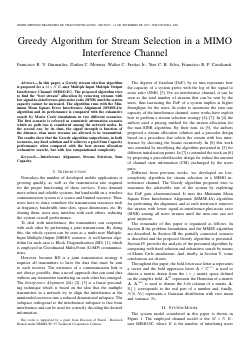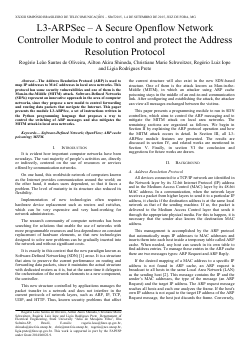
XXXIII Simpósio Brasileiro de Telecomunicações

Método para Atenuar a Degradação da Qualidade em Vídeo Streaming sobre IP
Carlos A. G. da Silva, Eduardo P. Ribeiro, Carlos M. Pedroso
DOI: 10.14209/sbrt.2015.21
Keywords: Video Streaming perceived quality redundancy
Abstract
Video streaming over IP is one of the applications with highest growth rate. In many cases, the quality of service in access networks is limited, which tends to reduce the quality of video playback. In parallel, multihoming communication systems allow the use of several interfaces for transmission. The availability of more than one interface for Internet access is increasingly common, especially with technologies as WIFI and mobile networks. This paper introduces a method for video stre- aming using multihoming to send redundant packets to reduce the impact of network impairments in viewer’s perceived quality. The efficiency of the method is demonstrated from computer simulations with videos encoded with H.264. The results show a significant reduction in quality degradation with small cost of redundant transmission.Download

Early Congestion Control : Melhorando o Desempenho do TCP em Redes Sem Fio
Marcos Talau, Mauro Fonseca, Anelise Munaretto
DOI: 10.14209/sbrt.2015.20
Keywords: Wireless multihop networks transport control protocol active queue management
Abstract
There have been many solutions for improving performance of TCP procotol over adhoc wireless networks. Several of these studies suggest changes in TCP, leading to changes in end points, which may be dif fi cult to implement. Other solutions seek to hide the problems in the TCP link, but which have proven to be ineffective. In order to improve TCP performance in these dynamic networks, this paper presents a cross-layer approach, implemented as an active queue management - AQM. The proposed method dynamically changes the value of window fi eld of TCP headers according to the rate of the router queue. The approach is TCP-Friendly. To assess the performance were conducted comparative tests with DropTail and the RED. The simulation results show that the new method improves throughput, delay and number of lossesDownload

Near ML Uplink Detection for Large Scale MIMO Systems
Alexandre Pereira Junior, Raimundo Sampaio-Neto
DOI: 10.14209/sbrt.2015.22
Keywords: Massive MIMO LAS detection Near ML detec- tion
Abstract
Transmission systems known as Massive Multiple- input Multiple-output (MIMO) offer exciting opportunitie s due to their high spectral efficiencies capabilities. On the oth er hand, one major issue in these scenarios is the high-complexity de tectors of such systems. In this work, we present a low-complexity, near maximum-likelihood (ML) performance achieving detec tor for the uplink in large multiuser MIMO systems with tens to hundreds of antennas at the base station (BS) and similar num ber of uplink users subject to antenna correlation and lognorma l shadowing channels. The proposed algorithm is derived from the likelihood-ascent search (LAS) algorithm and it is show n to achieve near ML performance as well as to possess excellent c om- plexity attribute. The presented algorithm, termed as rand om-list based LAS (RLB-LAS), employs several iterative LAS search procedures whose starting-points are in a list generated by random changes in the matched filter detected vector and choo ses the best LAS result. Also, a stop criterion is employed in ord er to maintain the algorithm’s complexity at low levels. Near- ML performance detection is demonstrated by means of Monte Car lo simulations and it is shown that this performance is achieve d with polynomial complexity on N t with order less then 2 per symbol, where N t denotes the total number of uplink users antennas.Download

Estudo de Detecção de Bordas em Imagens Usando Kernel
Bruna Cavallero Martins, Matheus Fuhman Stigger, Wemerson Delcio Parreira
DOI: 10.14209/sbrt.2015.30
Keywords: Edge detection kernel image processing
Abstract
This paper presents an application of the kernel functions in the image edge detection problem. In Support Ve ctor Machines SVM, the kernels are a measure similarity class. Thus, an algorithm for edge detection with pixel-to-pixel a nalysis is proposed for two kernels, the Gaussian and the Polynomial kernel. Simulation results are presented to show its perfor mance. The results were considered satisfactory, given the choice of the kernel and the kernel parameter(s).Download

Métricas de conectividade e vulnerabilidade em redes
William F. Giozza, Antonio C. Guimaraes, Anderson C. A. Nascimento
DOI: 10.14209/sbrt.2015.31
Keywords: critical infrastructure network security vulnerability structural and spectral metric
Abstract
Telecommunication networks are resistant to random faults, but they are highly vulnerable natural disasters or targeted attacks which disturb their critical points. This paper investigates ways to estimate the vulnerability of networks in terms of connectivity. By representing networks in form of graphs, we can derive structural and spectral measurements, based on invariants underlying the topology. To validate the results, these metrics are applied to models of Brazilian networks, in order to identify the most critical nodes and links.Download

Greedy Algorithm for Stream Selection in a MIMO Interference Channel
Francisco R. V. Guimar aes, Darlan C. Moreira, Walter C. Freitas Jr., Yuri C. B. Silva, Francisco R. P. Cavalcanti
DOI: 10.14209/sbrt.2015.27
Keywords: Interference Alignment Stream Selection Sum Capacity.
Abstract
In this paper, a Greedy stream selection algorithm is proposed for a M × N K -user Multiple Input Multiple Output Interference Channel (MIMO-IC). The proposed algorithm tries to find the “best stream” allocation by removing streams with low signal-to-interference-plus-noise ratio (SINR) until the system capacity cannot be increased. The algorithm runs with the Min- imum Mean Square Error Interference Alignment (MMSE-IA) algorithm and its performance is compared with the exhaustive search by Monte Carlo simulations in two different scenarios. The first scenario is refereed as symmetric attenuation scenario which no path loss is considered among the network nodes. In the second one, by its time, the signal strength is function of the distance, thus more streams are allowed to be transmitted. The results show that the Greedy algorithm outperforms, in both scenarios, any fixed solution and it achieves a good Sum Capacity performance when compared with the best stream allocation (exhaustive search), but with less computational complexity.Download

Estimating Network Impact of Charging Electric Vehicles in Smart Grid
Brenda Vilas Boas, Jean-Charles Grégoire, Aldebaro Klautau
DOI: 10.14209/sbrt.2015.32
Keywords: Vehicle to Grid Smart grid Fleet charging
Abstract
Within smart cities, electric vehicles (EV) rise as a sustainable transport and mobility option. Introduction of EVs to the grid requires control and management of electrical load where information and communication technologies (ICT) are the key to such interaction. This work presents a charging scenario and results from a tool built on MATLAB to estimate the communication load for charging electric vehicles in a fleet.Download

Alocação de Blocos de Recurso em Redes LTE com Estimativa de Limitante de Retardo através de Cálculo de Rede
Marcus Vinícius Gonzaga Ferreira, Flávio Henrique Teles Vieira, Marcelo Stehling de Castro, Sérgio Granato de Araújo, Flávio Geraldo Coelho Rocha
DOI: 10.14209/sbrt.2015.28
Keywords: LTE Scheduling Delay Network Calculus
Abstract
In this paper it is proposed an algorithm to allocate resource blocks for LTE (Long Term Evolution) communication systems which considers the delay target estimated through Network Calculus using service curve and MFBAP (Multifractal Bounded Arrival Process) envelope process in order to decide on the scheduling of available radio resources. Comparisons with other allocation algorithms are carried out through QoS (Quality of Service) parameters such as average delay, total throughput, processing time, loss rate and fairness index, proving the efficiency of the proposed algorithm.Download

L3 - ARPSec – A Secure Openflow Network Controller Module to control and protect the Address Resolution Protocol
Rogério Leão Santos de Oliveira, Ailton Akira Shinoda, Christiane Marie Schweitzer, Rogério Luiz Iope, Ligia Rodrigues Prete
DOI: 10.14209/sbrt.2015.29
Keywords: Software - Defined Network OpenFlow ARP cache poisoning ,MITM
Abstract
The Ad dress Resolution Protocol (ARP) is used to map IP addresses to MAC addresses in local area networks. This protocol has some security vulnerabilities and one of them is the M an - in - the - Middle (MITM) attack . Software - Defined Networks (SDNs) represent an innov ative approach in the area of computer networks, since they propose a new model to control forwarding and routing data packets that navigate the Internet . This paper presents the module L3 - ARPSec, a set of instructions written in the Python programming lan guage that proposes a way to control the switching of ARP messages and also mitigates the MITM attack in local area networksDownload

Variações da Decomposição Empírica de Modos para Realce de Sinais de Voz
L. Zão, R. Coelho
DOI: 10.14209/sbrt.2015.13
Keywords: speech enhancement empirical mode decomposition acoustic noise
Abstract
The empirical mode decomposition (EMD) has been adopted for the suppression of acoustic noise from speech si gnal in the time domain. This paper investigates two alternative methods to decompose and enhance speech signals collected i n noisy environments. After the decomposition, the Hurst exp onent is used to select the most corrupted modes. The results obtai ned in speech enhancement experiments prove that when compared to the EMD the alternative decomposition methods can lead to interesting speech quality and intelligibility improvementDownload